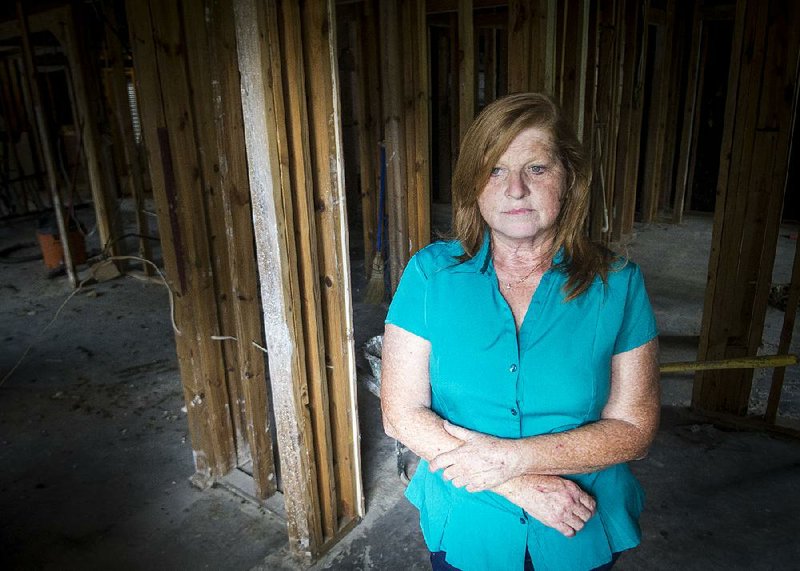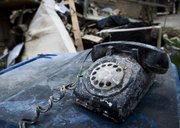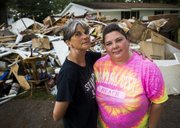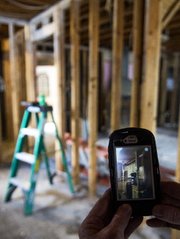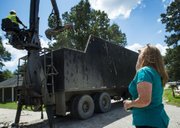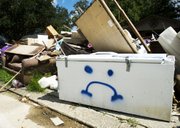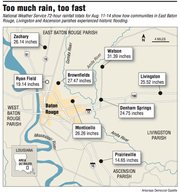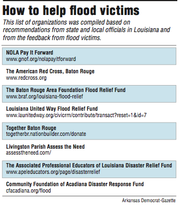DENHAM SPRINGS, La. -- A month after the flood, Debbie Millet's lifetime of memories could be found in a waterlogged debris pile as tall as her now-empty house.
RELATED ARTICLE
http://www.arkansas…">Louisianan beats D.C. bushes for $3B more in aid
In the mud-covered heap: Her mother's hospital bed. The letters her late father wrote while away on military duty. The furniture amassed over 40 years of marriage.
"It looks like a pile of junk, but all of it meant something to us," Millet, 55, said as she walked gingerly through her muddy yard to avoid the smelly stack.
Driving through Millet's Denham Springs neighborhood is like driving through a tunnel.
[VIDEOS: Click here for videos of the flooding in Louisiana]
Her neighbors' belongings, collected over decades and tossed out in a matter of days, tower over the street on both sides -- a daily reminder of the unprecedented flood that swamped much of this suburban city east of Baton Rouge four weeks ago.
The ruin stretches far beyond Denham Springs. For dozens of miles in every direction, south Louisianians' lives remain reduced to soggy, stinky mounds on the curb.
Since the mid-August floods, President Barack Obama has declared 22 parishes disaster areas.
Parts of those parishes remain submerged a month after the record-shattering rain finally ceased.
Like Millet (pronounced Mee-yay), thousands of residents have gutted their homes, intent on rebuilding.
For now, Millet lives out of a trailer parked in her driveway. Her home, like thousands of others, is uninhabitable.
"We've just gone into survival mode," she said.
Rain pounded south Louisiana unlike ever before from Aug. 11-14.
The relentless downpour overloaded the endless veins of rivers and bayous that make up this piece of the world.
Livingston Parish, where Millet lives, East Baton Rouge Parish and Ascension Parish bore the brunt of the unprecedented storms, which state officials estimate caused $8.7 billion in damage.
Unearthed caskets floated down streets, cars vanished beneath the water and 13 people drowned. More than 150,000 homes suffered damage, and high water forced the closure of portions of 300 state roads and two interstates.
More than 20,000 people needed rescues, according to Mike Steele, a spokesman for the Louisiana governor's Office of Homeland Security and Emergency Preparedness.
Afterward, the lucky ones had relatives to stay with. Others found kind strangers willing to house them. The less fortunate have spent more than a month in crowded shelters, some of which are starting to close.
'Absolutely historic'
No one saw this disaster coming.
Louisiana State Climatologist Barry Keim was at home with his family watching the Olympics when he first noticed the unrelenting rain.
"A steady rain like I've never seen before," he said.
By that time, it was already too late for some.
In one case, authorities found a woman's body in the Tickfaw River. Her husband and mother, who were in the car with her when the water swallowed it, survived by clinging to a treetop.
The storm -- a weak tropical disturbance -- stalled over the Baton Rouge Metropolitan Area for three days, trapped by "weather situations" to the east and west, Keim said.
"It had no pressure to move it," he said.
The clouds dumped 31.4 inches of water in one area, shattering Louisiana's two-day rainfall record, according to the National Weather Service. The deluge poured three times the amount of rain as Hurricane Katrina, and experts have called it the worst U.S. natural disaster since Hurricane Sandy.
For comparison, it took six months for 30 inches of rain to fall in Little Rock last year, according to the National Weather Service.
What if central Arkansas received that amount of rain in three days?
"Oh man, we've never had an event anywhere close," said Charles Dalton, a National Weather Service meteorologist in North Little Rock. "It would be absolutely historic, catastrophic. I can't say for sure, but I think 30 inches would push the Arkansas River over its banks."
Sinking heart
Aug. 13 started like a typical Saturday morning for Millet.
She and her mother, Mary Byrd, 77, had the house to themselves because Millet's husband was out of town. Millet planned a trip to the grocery store later in the day.
She peeked out the window and saw that water had started to pool at the end of her driveway. More amused than worried, she snapped a photo with her phone and continued about her day.
A commotion from her mother's room interrupted her a few moments later.
A small amount of water had crept into the converted room where Byrd lives, and she was trying to sweep the water back outside.
"Oh, no, Momma, that's not gonna work," Millet told her before moving Byrd and her walker to a couch in the family's still-dry living room.
Only 30 minutes later, the sofa was floating as water poured in the home.
The car was useless. Millet's neighbors and their boats offered the only escape.
Millet waded with her mother, who had a broken arm and never learned to swim, out the front door and got onto a small boat that could now be launched from the porch.
The boat only had room for one, so Millet, standing in her yard with water up to her waist, watched her mother motor away. They would reunite in a few minutes, she thought.
Millet returned inside to gather her two dogs, her cat, and her husband's and mother's medications. Then, she climbed into the next boat out and watched her home disappear into the rain.
Her heart sank when she reached dry ground at the end of the street.
Her mother wasn't there.
Streets into rivers
Disasters like these carry a sense of deja vu in south Louisiana. They hearken back to:
The 100-year flood in 1983.
Tropical Storm Allison in 2001.
Hurricane Katrina in 2005.
Hurricane Gustav in 2008.
Hurricane Isaac in 2012.
But what happened in mid-August was different. Keim, the state climatologist, called it a 1,000-year flood, meaning flooding of this magnitude has only a 0.1 percent chance of occurring in a given year.
"This is something we'll be studying for long time," he said. "Why was it able to turn the moisture available to it into rainfall so efficiently? That's the question we still need to answer."
The 4 trillion gallons of water the storm dumped were enough to fill 6 million Olympic-size swimming pools. Even the homes built to withstand Louisiana's worst weather were damaged.
Bridgette Dolan, 43, of Denham Springs lives in a house that was built in 1984 to the standards set after the 1983 flood. She was there through Katrina, Gustav and Isaac without water ever getting into the house.
She went to bed about midnight on Aug. 12. Six hours later, she awoke to water that, when she stood, was up to her knees.
Dolan's mother, Kay Goldbold, 60, lives a few miles away. Her home took on a few inches of water in 1983. On Aug. 13, the water inside her house reached 5 feet.
"Instead of streets, we had rivers," Goldbold said.
She, Dolan and their families are living in a camper in Goldbold's backyard.
'It'd float away'
In Denham Springs, the best way to determine how high the water rose is to look at the trees. Mud left behind forms a clear waterline on them.
Officials estimate that 90 percent of the homes in the town of 10,000 people were left underwater.
About 20 miles south in Ascension Parish, standing water remains in many homes a month after the flood. The parish is downstream from Denham Springs along the Amite River, and the water still has nowhere to go.
Jamie Clairday, 43, of Prairieville, La., used a small jon boat to get from the road to his front door in early September. His home, which backs up to Jim Bayou, still held several feet of standing water four weeks after the storm.
"I've flooded before, but never like this," he said, adding that he believes recently developed subdivisions around his home contributed to the drainage problems.
While Clairday paddled back and forth on Sept. 8, removing furniture from his house, his neighbor in the recently built development across the street put up a large inflatable Louisiana State University tiger. That subdivision didn't flood.
"If you put one of those things in my yard, it'd float away," Clairday said.
'Tumped over'
Byrd's doctors call her a walking miracle. She has lived through five heart attacks in four days and a brain aneurysm. Twice doctors revived her after her heart stopped. She had cancer removed from one eye, and she still has a mass in her lungs.
Byrd's family has said its final goodbyes twice when doctors expected severe infections to take her life.
She never lost her sunny disposition.
"Mom always says, 'God's not going to give you more than you can handle,'" Millet said. "I hope I have as much strength as her one day."
Millet and her mother share the same eyes and wide cheek bones. They each speak with the faintest of Cajun accents.
Byrd has two other children, both sons, so she and daughter Millet share a special bond. Since 2005, Millet has been her mother's caretaker, and they've grown even closer.
"My husband swears that if one of us gets cut, the other bleeds," Millet said. "I don't know how we could be any closer."
From inside the skeleton of her home early this month, Millet recalled the day floodwaters roared through her front door and destroyed nearly everything she owned.
In the past four weeks, the house has been stripped to its wooden frame and concrete slab. All that remains in furnishings are fans and a donated washer and dryer.
She wears new blue shoes with bright pink laces because all of her other pairs were lost. She twirls a pair of reading glasses in her hand because her prescription frames disappeared during the deluge.
Her eyes wander up to the exposed ceiling rafters as her thoughts drift back four weeks to when she couldn't find her mother.
"The boat tumped over, and she hit her head," Millet said.
'Here we are'
Recovering from a flood is a marathon and a sprint.
Financial aid packages have application deadlines, mold spreads quickly and living away from home is exhausting.
At the same time, flood victims face piles of paperwork and mountains of debris. Most are months away from any semblance of normalcy.
As time passes, volunteers who arrived to help return to their own lives, and donations wane. But the victims' burdens remain the same.
They spend long, hot days repairing their homes that have no air conditioning. Those lucky enough to still have jobs spend their days working and their nights rebuilding.
For many, sleep is elusive.
"You wake up every hour or two thinking about all the things you need to be doing instead of sleeping," Goldbold said.
There are the insurance claims, the red tape associated with Federal Emergency Management Agency disaster relief assistance and finding somewhere to sleep each night.
Some people can't even start repairs because of unclear local rebuilding regulations. In Denham Springs, for example, anyone whose home would cost more than 50 percent of its total value to repair must raise the foundation, and finding a contractor to evaluate a home is challenging.
Dolan called several contractors the week after the flood, and a four-week wait was the best she found.
FEMA approved $58.8 million through its individual housing program as of Sept. 8, according to agency spokesman Robin Smith. Statewide there were 139,868 applicants.
Federal aid for victims who did not have flood insurance is capped at $33,000 per household, although an analysis by The Advocate, a Baton Rouge newspaper, found that a typical aid package is about $8,000, based on recent high-profile natural disasters.
And FEMA won't help all victims. Goldbold was denied any assistance from FEMA because she had $50,000 in flood insurance, but that won't come close to covering all of the damage.
She and her husband recently lowered their flood insurance coverage. They thought they had seen the worst Louisiana weather could offer.
"My husband said that if we need more than $50,000, then all of Livingston Parish would be underwater. Well, here we are," Goldbold said.
Angels along the way
As rain soaked her and floodwater surged around her, Debbie Millet pleaded with a total stranger.
"Please don't leave," she begged the man who agreed to give her a ride in his truck. She handed him a tub with her two dogs, her cat and her mother's and husband's medications.
"This is all I have left."
Then, she waded into the muddy water that had already started to wash her town away, determined to find her mother.
For 90 minutes, Millet trudged against the current in search of Byrd. In deeper areas, she swam.
"Sewer waste, human waste, river water, that's all hitting you," she said. "Not to mention all the snakes."
All she knew at that point was that the boat carrying her mother had overturned close to a nearby cemetery, and that she had to find her.
Finally, she spotted her mother sitting in a stranger's gray truck.
"I'm telling you God must've put angels all along our way," Millet said.
As hard as the walk to find her mother had been, the walk back to her pets was even harder. With Byrd sandwiched between Millet and her walker, they slowly made their way through the rising current, stopping every few minutes to rest.
The pain in Byrd's broken arm was almost unbearable.
"All I wanted to do was get back to her pain medicine," Millet said.
As they walked, a passing car offered a ride, which Millet and Byrd accepted to get back to where Millet had left her pets and the medicines. She hoped and prayed the man hadn't left.
He was still there.
"Angels," Millet said.
For several days after the flood, they bounced around among several shelters, but at least they were together.
First, they went to a local pastor's home, but water rushed in soon after they got there. Then, they went to a church that was turned into a shelter. It too started to take on water shortly after Millet and her mother arrived.
At one point, a nurse examined Byrd and determined that she needed to be airlifted to a hospital because her heart rate and blood pressure were abnormal.
Byrd refused.
"I don't want to be separated again," Byrd told the nurse. "I'd rather die by [Millet's] side."
'This one's different'
Baton Rouge became the center of national media attention earlier this summer with the death of Alton Sterling at the hands of police and the subsequent slayings of three Baton Rouge police officers.
But locals complain that national media coverage of the flooding was scant, falling far short of that given to similar weather disasters like Hurricane Katrina and Hurricane Sandy.
"It's really astounding the lack of coverage, which can affect the amount of FEMA aid we get," said Venessa Lewis, a former journalism instructor at Louisiana State University whose home received extensive water damage.
Louisiana Gov. John Bel Edwards' office also noted what it perceived as too little media attention.
Steele, the spokesman for the governor's Office of Homeland Security and Emergency Preparedness, said some out-of-state volunteer groups learned about the extent of the damage weeks after the flooding, which occurred in the midst of a presidential campaign and the summer Olympics.
"There probably wasn't as much national coverage," Steele said. "As the governor and our congressional delegation have said, that may make it more challenging to get attention in Congress."
Edwards has made two trips to Washington, D.C., since the flooding to plead Louisiana's case for more relief aid.
And there have been angels along the way.
Flood victims are unrestrained in their praise of volunteers' efforts. One Arkansas-based nonprofit, Sheep Dog Impact Assistance, took a group of people to Baton Rouge to work at first-responders' homes.
Jeff Watts, central Arkansas chapter commander for Sheep Dog Impact Assistance, has responded to several natural disasters, but this one particularly struck him.
"This one is different," he said. "Just the scope of it. If you're not there and you can't see it up close, it's hard to understand, but everything these people owned is in their front yards. It's so sad."
Also, the United States Postal Service dispatched several postmasters and managers from Arkansas to help the affected post offices recover.
Not all of the responses have been kind. Looters stole nearly $35,000 from one local Wal-Mart, and they looted some of the affected neighborhoods.
In one east Baton Rouge neighborhood, a sign read, "You loot and I shoot."
One of Goldbold's neighbors sat on his porch with a gun, like a sentry, to discourage looters from stealing his neighbors' possessions.
"People that do that are the worst of the worst, but we stick together here in Louisiana," Goldbold said.
Long way off
Byrd sits at the tiny table inside the trailer she and Millet now share, sipping from a diet soda and reading a large study Bible. Her arm is still in a sling, and her head is still healing from the blow weeks earlier.
"This happened for a reason," she said, tapping her finger on the open Scripture.
For Millet, the events of the past six weeks haven't quite hit her yet. She hasn't had time to reflect or even to cry.
Her husband is staying in a mobile home park a few towns away. She doesn't even know where it is.
Every waking second has been spent carrying everything she owned to the sidewalk, filling out paperwork or taking care of her mother and herself.
Since she first noticed the water creeping into her house a month ago, "We've just gone into survivor mode," Millet said. Everything else has taken a back seat.
"Once we put our life back together, then I'll probably lose it," she said.
But that's a long way off.
SundayMonday on 09/18/2016

